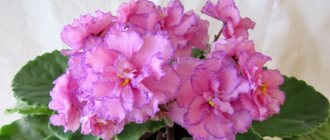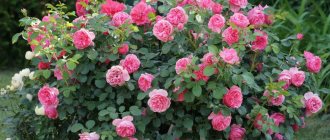In addition to tall roses, climbing varieties are widely used in landscape design, characterized by long and abundant flowering. Their use adds sophistication to any composition. For this reason, they are an indispensable element of the most daring design solutions. One such plant is the Swanee ground cover rose, or Swani as it is sometimes called. It has the ability to grow quickly and cover large areas of the bed, filling empty space.
Swanye cover roses do not require bushing.
History of selection
The ground cover rose Swany was bred in France in 1978. It was developed by Meilland. The founder of the Mayland nursery, Marie Louise, worked on the creation of this variety.
Two evergreen roses, Rosa sempervirens and Rosa wichurana, became the basis for the Swanee variety. The resulting variety was able to adopt only the best characteristics from its ancestors. This has made Swani one of the most popular ground cover varieties in cultivation.
Initially, the variety received the temporary name “MEIburena”, but at the first exhibition it was presented under its current name. Since then, Swany has become an innovative ground cover rose in its usefulness and decorative value, surpassing all other varieties known at that time.
Please wait. The request is being processed...
USDA Zone Six
The maximum possible winter temperature is up to -23C (Europe)
Disease resistance:
| Weak, the plant needs constant prevention: | + |
| Average, gets sick in unfavorable years: | ++ |
| Very good, practically does not get sick: | +++ |
Rain resistance:
| Weak, flowers do not open when it rains: |
| Medium, some flowers are damaged: |
| Very good, the flowers are not spoiled by rain: |
Bloom:
| Single flowering: |
| Reblooming: |
| Continuously blooming: |
| Modern Shrub | ||
| It was an important rose - the first groundcover rose developed by Meilhan, and still one of the best. Swany combines the genes of two evergreen roses, Rosa sempervirens and Rosa wichurana, but instead of being a vigorous climbing rose, it forms a spreading, profusely flowering bush. The flowers are pure white, with a soft pink tone in the center, when they first bloom, densely double, in the form of rosettes. They appear in clusters of 5-20 pieces on fairly long stems. The foliage is very beautiful, dark green, small, shiny, evergreen. The shape of the bush looks advantageous when planted on a slope. Can be used as a short climbing rose. (ARE) | Photo by vprzd Uploaded to website: vprzd | |
| Color: | white | |
| Number of flowers per stem: | 5-10 | |
| Aroma: | ? | |
| Flower size: | 5-6 cm | |
| Height: | 60-70 cm | |
| Width: | 150 cm | |
| USDA: | Sixth zone | |
| Resistance to powdery mildew: | ++ | ? |
| Black spot resistance: | ++ | ? |
| Rain resistance: | ? | |
| Bloom: | ? | |
| Bush shape: | Flower: | |
| Rosa sempervirens L. x Mademoiselle Marthe Carron |
Description and characteristics of the ground cover rose Svani
This rose is considered one of the most popular ground cover roses, and this is no coincidence. It looks attractive throughout the season and is easy to care for.
Ground cover rose Svani is a lush shrub with numerous creeping stems. It reaches a height of 50-60 cm and a diameter of 1.50-2.0 m, depending on growing conditions. The shrub has long, thin stems that bend well, but cannot be broken. They have dense foliage. The bark on young shoots is light green, but becomes dull brownish-gray with age. The branches are covered with small, round, hook-shaped spines.
Important: the ground cover rose Svani is fast-growing, so the plant grows to a full-fledged bush in the second year after planting.
Young leaves are light green; later they become darker and glossier. This significantly increases the decorative value of the shrub. The leaves alternate. They consist of 5-7 oblong-oval lobes, which are attached to a common petiole. Each segment does not exceed 2.0-2.5 cm in length and barely reaches 1.5 cm in width. The surface is smooth on both sides.
Rose Svani blooms continuously throughout the season. This is achieved through the constant growth of new shoots, at the top of which buds form. It begins in late May or early June, depending on the growing region. The flowers of this ground cover rose are quite large for their species. When fully opened, they reach 5-6 cm in diameter.
The shrub produces numerous, round, pointed buds, which are collected in umbrella-shaped inflorescences on long stems. Each umbel consists of 5-14 flowers, and the number of flowers on mature bushes can reach 20. The flowers consist of graceful, slightly curved petals. They are pure white, but may have a soft pink color in the center of the flower.
The rose has dense, 40-50 petals and a pleasant aroma.
The aroma is pleasant, floral, but weak. It increases slightly only in the late evening and at night.
Important: Rose Swaney is suitable for cutting, its flowers remain fresh for 3-5 days in a vase.
The root system is mainly concentrated in the upper layers of the soil. It branches and goes horizontally into the soil.
The white groundcover rose Swanee is moderately frost-hardy. This shrub tolerates temperatures dropping from -12 to -20 degrees. Since most of the plant's flowers are formed on last year's shoots, it must be covered for the winter. This is not difficult to do, since the ground cover rose forms a low bush.
Under favorable conditions, it is practically resistant to fungal diseases. However, in case of prolonged rains and cool weather, the plant's resistance will be reduced. To avoid this, preventive spraying of bushes with fungicides should be carried out.
Distinctive features of the plant
Ground cover roses are a creeping plant characterized by a spreading crown. Due to this feature, this crop is able to form a thick carpet of beautiful flowers of different colors on the site. Several gradations are used for the group of ground cover roses, including the following:
- dwarf - bush height - up to 45 centimeters, width - 1.5 meters;
- low creeping - up to 50 centimeters and over 1.5 meters, respectively;
- low-growing drooping ones - up to 0.4-0.6 meters and 1.5 meters;
- tall drooping ones - over 90 centimeters and 1.5 meters.
For several years after planting, the first two varieties of roses form a dense carpet formed from many rooted shoots. Thanks to this feature, the culture is able to hide the flaws of the site.
If you properly care for the plant, flowers with a diameter of 1-10 centimeters (depending on the variety) will appear on the bushes every year. When choosing ground cover roses, you should take into account the growth characteristics of the shrub. More varieties on the website https://dachamechty.ru/tsvety/roza/pochvopokrovnye.html. Some varieties are distinguished by shoots that bend into an arc as they develop.
Advantages and disadvantages of the variety
According to the description, photographs presented and the opinions of gardeners, the ground cover rose Svani is characterized by high decorativeness and low maintenance requirements, which distinguishes it from other varieties. However, like other varieties, it has both advantages and disadvantages. Therefore, when choosing, you should pay attention to them, so that later it does not become an unpleasant surprise.
The flowers of the undergrowth are rosette-shaped.
The main advantages are:
- Long, abundant flowering;
- Versatility of use in landscape design;
- Easy care;
- Good frost resistance;
- Resistance to fungal diseases;
- High decorative value;
- large flower diameter;
- suitable for cutting;
- easy to reproduce;
- recovers quickly in case of frost.
Flaws:
- The shrub does not have the ability to self-clean;
- weak floral aroma;
- Roses become less decorative if it rains for too long;
- Requires shelter for the winter.
Usage
Fairy tail ground cover rose planting and care
Svani roses grow well in flower beds and artificial flowerpots
Rose "Swani" quickly turns into a lush, spreading bush that can gracefully hang over a slope, so sloping areas are considered the ideal place for planting this variety. “Swani” is actively used to decorate borders and paths. The variety looks great both in simple flower beds and in complex mixborders; it grows well in containers and containers that can be placed throughout the garden plot. Ground cover roses will grow well in artful flowerpots or flower beds located on a hill. Delicate thin stems will gracefully hang from planting containers, decorating the garden area with lush flowers.
Growing in various containers also has practical benefits: it is easier to fertilize the soil in confined spaces and it is easier to arrange a good drainage system, and these two conditions will contribute to more luxuriant flowering of roses.
The snow-white flowers of the “Swani” rose look especially chic in white gardens. An excellent background for them can be dark green shrubs that will set off the lush white blooms of roses. Honeysuckle, viburnum, lilac and brilliant cotoneaster are suitable as such a background.
Rose “Swani” goes well with other flowers
You should not neglect coniferous shrubs, which will fit perfectly into the garden where “Svani” roses grow. Cossack juniper and mountain pine are suitable as neighbors for roses, which will dilute and highlight the snow-white caps of rose bushes. Orange daylilies and sky-blue delphiniums will look great next to roses.
The ground cover rose "Swani" has some qualities of climbing varieties, so you can try decorating gazebos, pergolas, fences and hedges with white buds.
In addition to purely decorative decoration, roses can also bring practical benefits: if they are planted on a slope with deteriorating soil, they will compact the top layer and protect it from erosion during precipitation.
Varieties of Svani roses
The enormous popularity of the ground cover rose Svani inspired its creator to create other varieties based on it. They all have common characteristics, but there are also clear differences. So make sure you are familiar with the popular subspecies of Swana to avoid any confusion.
Important: Swana Mimini cover roses are not self-cleaning plants, so the bushes must be pruned regularly to prevent the flowers from wilting, which reduces the aesthetics of the plant.
Swany Mimi
Introduced in 2001, it was technically named MEIshasen. Swany Mimi is characterized by medium growth and its stems are almost thornless. Its buds will be pink at first, but as they open, the outer petals become light, and only the center remains light. This gives it a very delicate and elegant look. Roses are no more than 3 cm in diameter. But the bush produces a huge number of them, so when they bloom, the leaves are almost invisible.
In many catalogs, the rose Mimi Swany is listed as Mimi Eden.
Super Swany
Introduced in 1987. Super Swani forms spreading bushes, rarely reaching 1.4 m in height. Its flowers are densely double, almost white, but may have a slight pinkish tint along the edges of the petals. Their diameter is about 5-6 cm.
Rose Super Swany is odorless.
Pink Swany
This ground cover rose was introduced in 2003 and is specifically designed for planting in groups. Pink Swany has dense, open flowers in which even when fully opened the center of the flower is not visible. The bushes reach a height of 60-80 cm and a diameter of about 110 cm. But since each flower has 90-100 petals, it looks much larger than its size. The flowers are a shade of pink with a slight hint of purple. They reach 7-8 cm in diameter.
The pinkish hue of the Peak Swany cover rose is vibrant in the spring and fades in the fall.
Rose Red Swany
A cover rose with a spreading head up to 2.0 m in diameter and about 60 cm in height. Red Swany rose has bright red flowers with a delicate aroma. It is also characterized by delicate petals. The flowering period is long, beginning in early summer and continuing until autumn frosts.
The Red Swanee cover rose does not require pruning.
Planting a flower
In order for the rose to develop well, bloom richly and not get sick, you need to follow some recommendations during planting:
- 1Rosa does not like drafts, you need to look for a windless place.
- 2The area should be sunny or slightly shaded.
An important point: the rays must illuminate the bush well before lunch, so that the morning dew quickly evaporates.
It is best to plant roses in open ground in September-October. It will have time to take root before the beginning of winter, and in the spring it will actively begin to grow.
It is possible, but not advisable, to plant in the spring from mid-April to the end of May; in this case, the rose lags behind in development by two weeks and blooms later.
If the bush is planted in the spring, then the shoots should be 15 cm, the rhizomes about 30 cm. After planting, the plant is covered with film.
Before planting in the ground, seedlings are soaked in water for a day. The root collar goes 8-10 cm deep into the soil. If it is left outside the soil, the rose will degenerate into a rose hip. The buds that are located below the graft site are cut off, and the area is treated with charcoal powder.
Tip: The hole should be 50 cm deep, 60-70 cm in diameter. Fill it with plump, moisture-absorbing soil mixed with humus and a special composition containing minerals. To neutralize some of the acidity of the soil, wood ash is thrown into the hole. Immediately after planting the roses, install supports.
It is better to fasten the branches to the stand with plastic twine, but it is not recommended to use metal wire, even covered with an insulating layer: they can damage the stem, an infection will get into the wound, and the bush will get sick. The gratings must be dug in at a distance of at least 40 cm from the base of the rose, so as not to damage the root system. After planting, abundant watering and hilling to a height of 20 cm are required.
Tip: To prevent melt water from flooding the rose in the spring, you need to choose areas with a slight elevation. Places close to groundwater should be avoided.
Reproduction methods
This variety is easily propagated by pruning and cuttings. The first of them is simple and can be used even by an inexperienced gardener. It is enough to bury several shoots 5-10 cm deeper into the soil, leaving only the tops, and keep the soil slightly moist throughout the season. Next year you can separate the shoots from the mother bush.
The cutting method is more complicated, but allows you to get a large number of cuttings. To do this, before flowering, cut the shoots into pieces 10 cm long with 2-3 internodes. Remove the lower leaves completely and leave the upper ones to release the juice. Then dust the cuttings with any rooting agent and plant them in the soil. Cover them with transparent lids to create optimal conditions. Young seedlings can be transplanted to a permanent place only at the age of 2 years.
Growing and care
Cover rose Svani can be planted in open ground in spring in the central and northern regions and in autumn in the southern regions. Plant in sunny, slightly shaded areas with fertile soil and good aeration.
Do not plant this variety in the shade, otherwise it will not bloom profusely.
2 weeks before planting, prepare a planting hole measuring 50 x 50 cm. A 7-10 cm layer of drainage is placed at the bottom, and an equal volume of soil mixture of turf, sand, mulch and peat is poured on top. When planting, the root collar of the seedling should be buried 2 cm.
Important: When planting Svani ground cover roses, the groundwater level must be at least 80 cm below the groundwater level.
Standard care instructions must be followed when growing this variety. These include timely watering in the absence of seasonal precipitation. Use water with a temperature of +18-+20 °C. Watering should be done in the evening to avoid burning the leaves.
Cover rose Svani also needs nutrients. Therefore, in the spring, at the beginning of cultivation, apply nitroammophoska fertilizer (30 g per 10 l) or fermented chicken manure (1:15). Then add mineral mixtures of phosphorus and potassium, which will increase the number of buds, prolong flowering and increase the frost resistance of the bush. The frequency of their use is once a month.
To prevent the growth of weeds under the shoots of the Swaney rose, cover the shoots with a 3 cm layer of tree bark. This mulch not only reduces watering, but also prevents overheating of the roots in hot weather and ensures an acidity level of about 6.0-6.5 pH.
The ground cover rose Svani does not need to be formed. Therefore, every spring it is only necessary to remove damaged and frozen shoots, which reduces its decorative value. The bush must be covered for the winter. To do this, first cover the root system with a thick layer of soil and compact it. The entire rose should then be completely protected by a layer of non-woven material.
Important: In early spring, without waiting for intense heat, remove the cover from the Swanee cover rose, otherwise it will wither at the base.
Agricultural technology
We have already written in detail about planting, pruning, care, and tying climbing roses to supports. We will repeat only the main points, and will focus on the peculiarities of cultivating the “Don Juan” variety.
Placement and boarding
The rose will grow most comfortably in a sunny place protected from the wind. But it grows well in partial shade without losing its decorative qualities. In fact, the sun that it can receive in the first half of the day is quite enough for this variety - you can place it so that in the afternoon it is deprived of direct sunlight.
The best time to plant roses is spring and autumn. Moreover, in regions with a cool climate and harsh winters, it is best to plant them in April-May, so that the plant can take root during the warm season, and in the southern regions - in the fall.
If you are planting the “Don Juan” variety near the wall of a house, dig a planting hole no closer than 40 cm from the support. It should be 60 cm in diameter and 30 cm deep. Pour a little planting mixture into the bottom of the hole and place the seedling in it so that its roots are directed in the opposite direction from the wall. Sprinkle them with the prepared substrate, tamp them down carefully, add soil and water generously. For this you will need at least 15 liters of water. Hill up the rose, no matter what time of year you plant it.
If your soil is poor, add a bucket of well-rotted compost or humus.
If you are planting several climbing roses, the distance between the bushes should be at least 3 meters.
Seasonal care
In the first months after planting, especially if it was done in the spring, the rose must be watered abundantly, spending at least 15 liters of water per bush. In the future, water the plant as the soil dries, since climbing varieties require more frequent watering than other varieties. Watering should be plentiful.
Feed this variety of rose regularly - it grows quickly and blooms profusely throughout the season, therefore, it requires increased nutrition. Foliar feeding gives very good results. The rose also needs loosening of the tree trunk circle, especially if you have not mulched it.
Formation of a bush
Rose “Don Juan” can be formed on a trellis - against the wall of the house, on a pergola, trellis or trellis, placing the main branches horizontally or in a fan and tying them with strong twine or thick wire in a plastic braid.
A plant formed around a pole, on an arch or next to a large tree will look very good. In this case, the main shoots are directed vertically and tied to a support.
Rose "Don Juan" has powerful thick stems. It can not be tied to a support, but formed in the form of a tapeworm (single focal plant) or a hedge (in this case, the distance between the bushes when planting is reduced to 2 meters).
Trimming
From a young rose, cut out only weak and immature shoots. If you grow the Don Juan rose on a trellis, then every spring, immediately after removing the winter shelter, cut out all frozen and weak shoots, shorten the main and skeletal branches by a third. All young branches from last year that are not needed for the further formation of the bush, cut by a third or remove completely - the “Don Juan” rose blooms on the young growth of this year.
When growing a plant without support, only sanitary pruning and trimming of excessively long vines will be mandatory if they suddenly go “in the wrong direction.”
Shelter for the winter
The “Don Juan” variety has high frost resistance, but this does not mean that it is able to winter without shelter and does not freeze. The more severe your climate, the more severe the shelter.
With the onset of the first frost, the rose is removed from its support, all weak or immature shoots are cut out, spud up and laid on spruce branches, covering the lashes on top with it. If a harsh winter is expected, the spruce branches are covered with agrofibre or spunbond.
It is very important to remove it on time - the roses are more likely to be destroyed by damping off than by freezing. We offer you to watch a video dedicated to growing and caring for the climbing rose “Don Juan”
There you will also hear reviews from flower growers about its winter hardiness and decorative properties:
We offer you to watch a video dedicated to growing and caring for the climbing rose “Don Juan”. There you will also hear reviews from flower growers about its winter hardiness and decorative properties:
Pests and diseases
This variety demonstrates resistance to diseases and pests. However, if the growing conditions are unsuitable and the plant is not properly cared for, the resistance of the Swanee rose is reduced.
Possible problems:
- Powdery mildew. The disease manifests itself as a white coating on the leaves, which then becomes a dirty gray color. This interferes with photosynthesis and causes leaves to wilt. Topaz should be used as a treatment.
- Black spot. The disease develops with sudden changes in day and night temperatures. Initially, black spots appear on the leaves, which then turn into spots. Eventually, premature defoliation occurs and the shoots become completely bare. Skor should be used as a preventive and therapeutic agent.
- Aphid. A small pest that develops on young leaves and shoot tips. It feeds on rose juice. If the infection is severe, the flower buds become deformed and the bush stops blooming. Contact Confidor Ekstra.
- Spider mite. A microscopic pest that cannot be seen with the naked eye. It can be recognized by dull leaf color, slow growth, misshapen buds, and tiny webs on the tops of branches. Actellik should be used.
Reviews
Tatyana Evseeva
July 14, 2019
A ground cover rose was needed to fill the space in the rose garden with scrub and climbing roses. I chose this variety because the white color was missing.
In our zone of moderately cold climate in the northern region of Belarus, roses have a hard time. I planted the purchased two-year-old seedling on an elevated, well-lit place in a planting hole filled with special soil for roses.
Rose Swany blooms continuously for me from the beginning of June until the first frosts in November. Flowering begins with the slow blooming of white, densely double flowers, collected in inflorescences. In July, a spreading bush a meter in diameter with creeping shoots becomes a lush blooming meadow of roses exuding a pleasant light aroma. During the season, in intense heat, the inflorescences quickly fade and need to be removed, but new flowers appear just as quickly.
Heavy rain also interferes with beautiful flowering; the flowers become contaminated with soil. But despite various weather conditions, the rose is very resistant to disease, and I have never had to treat it. It is also slightly damaged by insect pests; I only treat it against aphids once a season.
It overwinters well in a rose garden with other roses under a common airy cover made of white double non-woven material.
Yana Lisowa
August 14, 2019
What fertilizer do you use for roses? When do you deposit?
Andriy Klim
November 27, 2020
Friends have this variety. When it blooms, almost no leaves are visible behind the flowers.
Irina Vorobyova
September 28, 2019
A very beautiful rose, blooms thickly twice a season, and has a pleasant scent.
Yana Lisowa
March 26, 2020
How wide is the bush? Is it growing a lot? If so, and with abundant flowering, then great)
Evgenia Zvonova
June 11, 2018
I have an ambivalent attitude towards this rose. On the one hand, it has a very beautiful flower shape, very abundant and long-lasting flowering, excellent health and powerful growth force, the rose winters well, but on the other hand, there are quite a few disadvantages...
I bought this rose as a scrub - I wanted to have a not very tall plant on the site that blooms profusely with white flowers. Swany, judging by the description, was ideal: the flowers are not large, collected in multi-flowered clusters, the color of the petals is snow-white with a slightly noticeable pleasant pink tint, but in reality everything turned out to be wrong: the bush grew quickly, and by the middle of the second year it became big, no way didn’t want to keep its shape (it was falling apart), no supports helped, there were really a lot of flowers (it blooms like an “avalanche”), but the flowers don’t have the ability to “self-clean”, that is, the petals don’t fly around on their own, because of this the bush looks dirty and not neat (constantly coming up and cutting so many flowers is problematic).
But I didn’t part with the variety - on the advice of a friend, I transferred it to the category of ground cover. Now I couldn’t be happier with the rose – it grows in the very sun like a dense carpet, even the weeds don’t break through the “foam” of the flowers. In the conditions of the Middle Volga, flowering continues all summer.
Yana Lisowa
March 26, 2020
Something that does not self-clean is, of course, not convenient. Although I don’t have many self-cleaning roses, I’m somehow used to cleaning up what has faded
autorenew
Load more varieties
Application in landscape design
Swani ground cover rose is widely used in landscape design. Its drooping stems can camouflage any unsightly surfaces. Therefore, it is often planted on slopes and near high borders. It is also ideal for alpine beds, front beds and for landscaping the entrance to pergolas.
Svani Stem Rose is also available for commercial use as its flowering stems look very elegant when raised, giving the appearance of a floral fountain.
It can also be grown as a planter to decorate balconies, terraces and stairs.
Preparing for winter
Rose omazh barbara
For better preparation for winter and ripening of shoots in the fall, stop watering and fertilizing roses.
Ground cover plants are considered winter-hardy and do not require shelter.
In the domestic climate, this is true only for the southern regions and areas with mild, snowy winters. It is advisable to protect the bushes with spruce branches or lucrasil, creating an additional air cushion.
Ground cover roses are unpretentious in care and cultivation, beginner gardeners can handle it
They respond to care and attention with abundant blooms and delight with a riot of colors, grace, and spectacular decorativeness.











